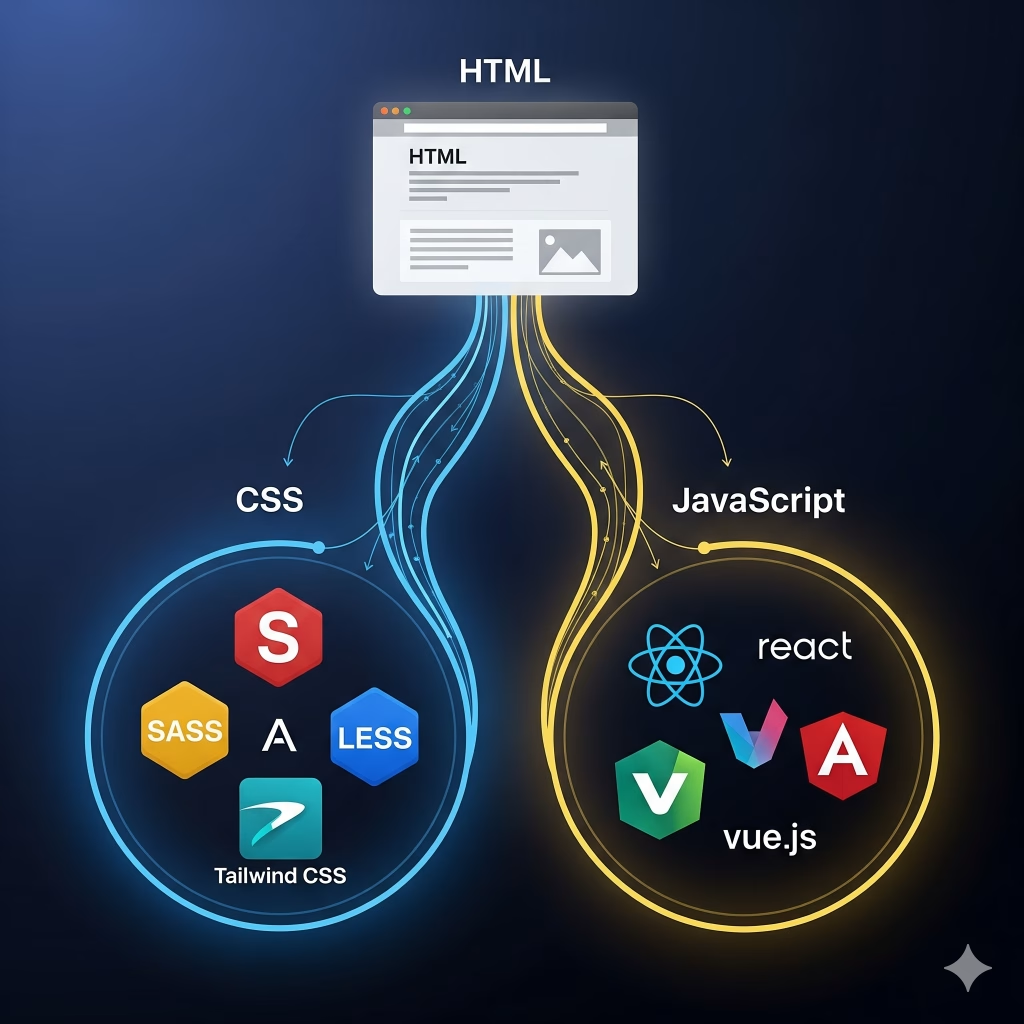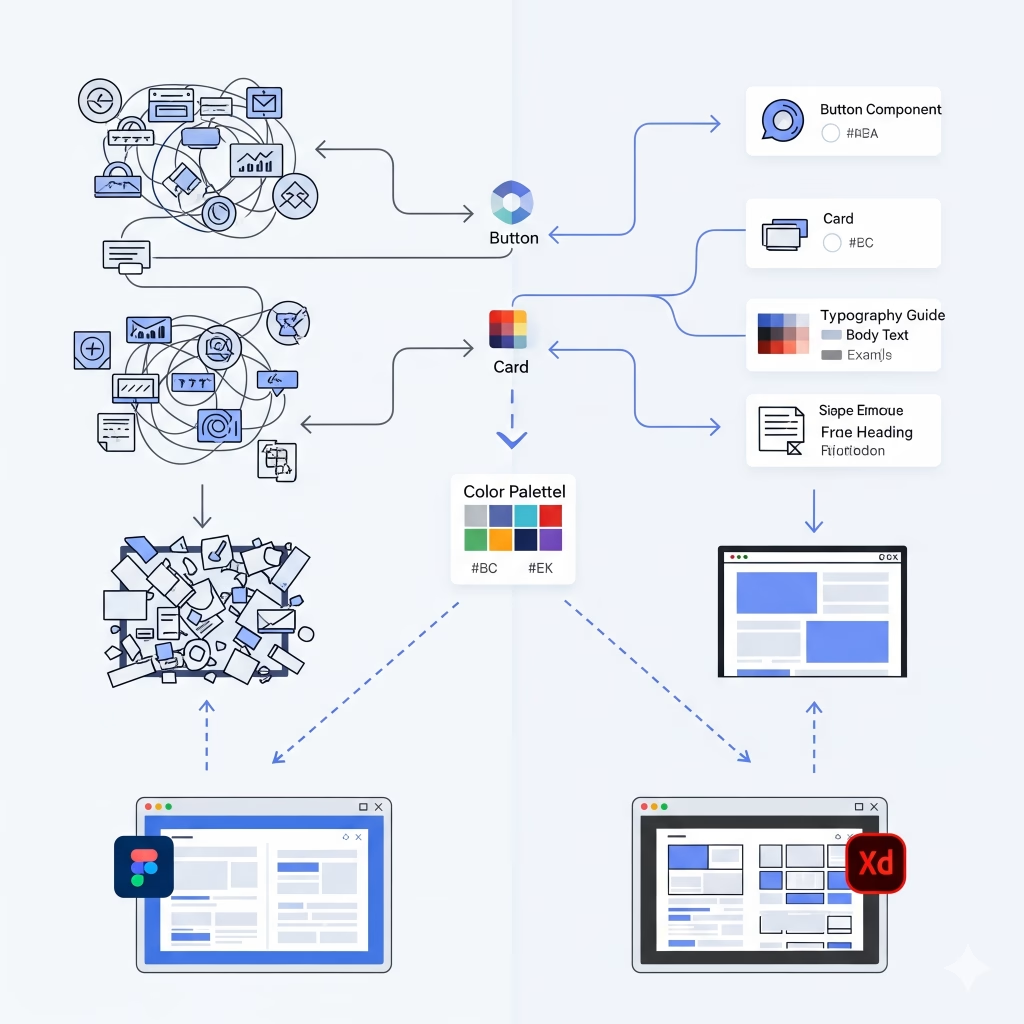Front-end design relies on a combination of technologies, frameworks, and tools to create visually appealing, interactive, and responsive user interfaces.
1. Core Technologies (The Foundation)
These are essential for every front-end project:
- HTML5 → Structures content (semantic tags, forms, accessibility).
- CSS3 → Styles layouts (Flexbox, Grid, animations, variables).
- JavaScript (ES6+) → Adds interactivity (DOM manipulation, event handling).
2. CSS Preprocessors & Frameworks
- Sass/SCSS or Less → Extends CSS with variables, nesting, and mixins.
- Tailwind CSS → Utility-first framework for rapid styling.
- Bootstrap → Popular UI kit for responsive grids and components.
3. JavaScript Frameworks & Libraries
Used for dynamic, single-page applications (SPAs):
- React.js (with JSX) → Component-based UI (Meta/Facebook).
- Vue.js → Progressive framework (easy integration).
- Angular → Full MVC framework (Google).
- Svelte → Compiles to vanilla JS (no virtual DOM).
4. State Management (For complex apps)
- Redux (React) / Pinia (Vue) → Centralized state management.
- Context API (React) → Lightweight state handling.
5. Build Tools & Module Bundlers
- Vite → Blazing-fast modern bundler.
- Webpack → Bundles assets (JS, CSS, images).
- Babel → Transpiles modern JS for older browsers.
- npm/Yarn/pnpm → Package managers for dependencies.
6. Version Control & Collaboration
- Git → Tracks code changes.
- GitHub/GitLab/Bitbucket → Hosting and collaboration.
7. Testing & Debugging
- Jest → JavaScript testing framework.
- Cypress/Playwright → End-to-end (E2E) testing.
- Chrome DevTools → Debugging and performance analysis.
8. Modern CSS & Layouts
- CSS-in-JS (Styled-components, Emotion) → Scoped styles in JS.
- CSS Modules → Locally scoped CSS classes.
- Container Queries → Responsive design beyond viewports.
9. Animation & Interactivity
- GSAP → Advanced animations.
- Framer Motion (React) → Declarative animations.
- Three.js → 3D graphics in the browser.
10. Static Site Generators (SSGs) & JAMstack
- Next.js (React) → SSR/SSG hybrid.
- Nuxt.js (Vue) → SSR/static site support.
- Astro → Island architecture for performance.
11. APIs & Data Fetching
- REST APIs → Traditional data fetching (
fetch, Axios). - GraphQL → Efficient queries (Apollo, Relay).
- WebSockets → Real-time updates (Socket.io).
12. Design & Prototyping Tools
- Figma → UI/UX design and collaboration.
- Adobe XD/Sketch → Alternative design tools.
- Storybook → Component library documentation.
Key Takeaways
- For simple sites: HTML, CSS, JS + maybe Bootstrap.
- For dynamic apps: React/Vue/Angular + state management.
- For performance: Vite, Next.js, or Astro.
MORE LINKS:
Front end includes?
Mobile version of a site
Seo optimized design
Match existing branding
I need animations?!
How long it takes?
Preview the design
Provide source files
Typical includes
TECHNOLOGY USED FOR FRONT END DESIGN
When considering the question of what technologies are used for front end design, it is important to understand that front end development is not just about choosing a single tool or programming language but rather about orchestrating a complex ecosystem of interconnected technologies, frameworks, methodologies, and design principles that together create the visual and interactive layer of the web. At its core, front end design involves HTML, CSS, and JavaScript, which act as the foundation for building any modern web interface, but the conversation cannot stop there because in practice these core languages are extended and augmented by a wide range of frameworks and libraries that allow developers to implement responsive layouts, create reusable components, integrate animations, manage states, and ensure accessibility for a diverse range of devices and users. To illustrate, while HTML provides the structure and semantic foundation of a site, CSS is used for styling and layout control, yet instead of writing raw CSS line by line, professionals often rely on advanced tools such as SASS, LESS, or PostCSS to organize their styling logic and maintain consistency at scale, and even more commonly they use utility-first frameworks such as Tailwind CSS or component-based systems like Bootstrap that allow faster development while still supporting full customization. JavaScript, on the other hand, has evolved beyond its origins as a scripting language for simple interactions to become the driving force of modern front end engineering, and it now powers everything from dynamic DOM manipulation to full single-page applications through ecosystems like React, Vue.js, and Angular, each of which offers component-based architectures, efficient rendering strategies, and extensive community-driven libraries that can be plugged into nearly any project. These technologies collectively shape how a website looks, feels, and performs, which is why the selection of the right combination is never random but must be aligned with the project’s long-term goals, scalability requirements, and the expectations of its target audience.

Beyond the core frameworks, front end design also increasingly incorporates advanced practices such as responsive design, accessibility compliance, performance optimization, and integration with back end services, all of which require developers to be aware of both technological and human-centered considerations. Responsive design ensures that websites adapt gracefully to various screen sizes, from large desktop monitors to small mobile devices, and is achieved not only through CSS media queries but also through flexible grid systems, fluid typography, and the use of scalable vector graphics instead of fixed raster images. Accessibility, often abbreviated as a11y, ensures that websites are usable by people with different abilities, including those relying on screen readers or keyboard navigation, and frameworks like ARIA standards play a crucial role in implementing these practices. Performance optimization is another critical aspect because modern users expect sites to load in seconds, and this requires front end developers to implement techniques like lazy loading, code splitting, minification of assets, caching strategies, and the use of modern build tools such as Webpack, Vite, or Gulp, which bundle and serve optimized assets for production. Furthermore, as applications grow more complex, state management tools such as Redux, Pinia, or Vuex are often employed to keep user interactions predictable and scalable. The role of APIs and data integration is equally important because modern front end technologies rarely operate in isolation, instead they communicate continuously with servers through REST APIs or GraphQL, which enables more efficient data querying. Taken together, these practices demonstrate that front end design is not a simple matter of styling pages but an intricate discipline that bridges user expectations with technical execution.

Another dimension of modern front end design lies in the adoption of design systems and component-driven development methodologies, which are increasingly essential for organizations that require consistent branding and scalable solutions across multiple digital properties. Design systems are essentially collections of reusable components, guidelines, and best practices that ensure a unified user experience across products, and they often leverage technologies such as Storybook to document and showcase UI components in isolation. By standardizing the building blocks of a website or application, front end teams can work more efficiently, reduce redundancy, and avoid the inconsistencies that come from ad hoc styling. This practice is complemented by the use of collaborative design platforms like Figma or Adobe XD, which allow designers and developers to work together in real-time and bridge the gap between design concepts and actual implementation. In addition, component-driven frameworks like React or Vue encourage developers to think of interfaces not as static pages but as modular systems where each button, form, or card is a self-contained element that can be reused across contexts. This modular approach significantly accelerates development, reduces bugs, and provides greater flexibility in adapting to new requirements. From an organizational perspective, this shift also allows companies to scale their web presence more easily because once a design system is established, creating new pages or entire websites becomes a matter of assembling existing pieces rather than reinventing the wheel. This trend demonstrates how front end design has evolved from static page-building into a discipline that emphasizes scalability, consistency, and collaboration across disciplines.
Finally, it is worth acknowledging the rapid evolution of front end technologies and how this affects the decision-making process for businesses and developers. New frameworks, libraries, and tools are released constantly, each promising better performance, easier learning curves, or more elegant solutions to common problems. While it may be tempting to adopt the latest tool, experienced developers recognize that stability, long-term support, and ecosystem maturity often matter more than novelty. For example, while React continues to dominate the landscape with its massive ecosystem and community, alternatives like Svelte are gaining traction for their simplicity and performance optimizations, and tools like Next.js and Nuxt.js provide server-side rendering capabilities that enhance SEO and load times for large-scale applications. On top of this, advances in web standards themselves are continuously reshaping front end design: features like CSS Grid, Flexbox, and CSS custom properties have fundamentally changed how layouts are implemented, while Web Components offer a native way of building encapsulated reusable elements without relying on third-party frameworks. The future of front end design will likely involve even tighter integration with AI-driven tools that assist with code generation, automated accessibility testing, and intelligent design recommendations.

